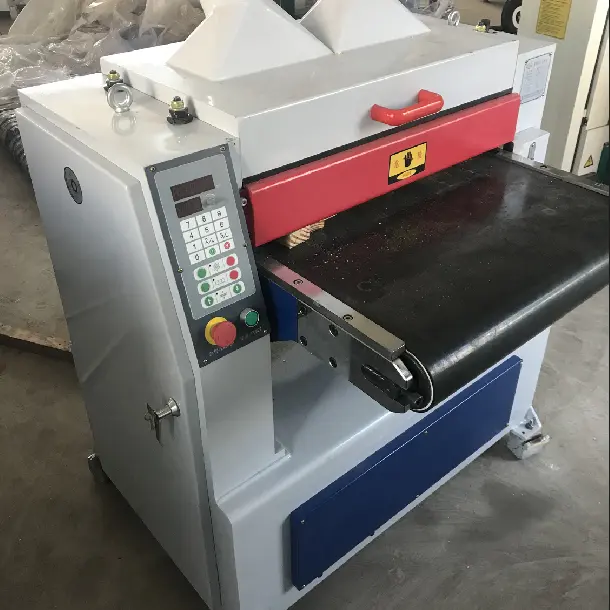Woodworking is a craft that has been cherished for centuries, evolving from simple hand tools to complex machinery. Among the many tools available to the modern woodworker, the belt planer stands out as a game changer. This powerful tool not only increases precision and efficiency on woodworking projects, it also opens up new possibilities for creativity and craftsmanship. In this comprehensive guide, we’ll take a deep dive into the world of planers, exploring their features, benefits, and best tips for using them.
Learn about belt thickness planers
A belt planer, often simply called a planer, is a woodworking machine designed to trim boards to a consistent thickness throughout their entire length. Unlike traditional planers that use rotating blades, belt planers use an abrasive belt to achieve a smooth, even finish. This distinction makes them particularly suitable for processing a variety of wood types, both hardwood and softwood.
Main features of belt thickness planer
- Abrasive Belt: The defining feature of a belt planer is its use of an abrasive belt. These abrasive belts come in a variety of grit sizes, allowing woodworkers to choose the appropriate abrasive level for their specific project. Coarse abrasive grains are ideal for initial material removal, while finer abrasive grains provide a polishing effect.
- Adjustable Thickness Settings: Belt thickness planers come with adjustable settings that allow the user to control the thickness of the wood being processed. This feature ensures precision and consistency, making it easier to achieve the desired dimensions for each piece of wood.
- Feed Rate Control: Many belt thickness planers offer adjustable feed rates, allowing the woodworker to control the speed of the wood through the machine. Slower feed speeds are ideal for achieving smoother surfaces, while faster feed speeds are suitable for rapid material removal.
- Dust Removal System: Carpenters produce a lot of dust and debris, which is harmful to both the woodworking machine and the machine. Belt gauges often feature integrated dust collection systems that help keep the workspace clean and reduce the risk of respiratory problems.
- Sturdy Structure: A strong and stable structure is essential for any woodworking machine. Belt gauge planers are typically constructed from durable materials to withstand the rigors of frequent use and ensure long-lasting performance.
Benefits of using a belt thickness planer
- Accuracy and Consistency: One of the main advantages of using a belt thickness planer is the ability to achieve precise and consistent thickness across multiple pieces of wood. This precision is critical for projects that require consistency, such as cabinetry and furniture making.
- Time Efficiency: Belt thickness planers significantly reduce the time and effort required to achieve the desired thickness. While traditional hand planing can be labor-intensive and time-consuming, a belt planer streamlines the process, allowing the woodworker to focus on other aspects of the project.
- VERSATILITY: Belt thickness planers are versatile tools that can handle a variety of wood types and sizes. Whether processing rough or reclaimed wood, these machines can transform uneven and rough surfaces into smooth, workable parts.
- Improved surface quality: The use of abrasive belts ensures a high-quality surface finish, minimizing the need for additional sanding. This not only saves time but also enhances the overall look of the finished product.
- Cost Savings: Investing in a belt thickness planer can bring long-term cost savings. By processing raw materials efficiently, woodworkers can maximize their lumber inventory, reduce waste and minimize the need for additional purchases.
Best Tips for Using a Belt Thickness Planer
- Choose the Right Grit: Choosing the right grit for your project is crucial. Start by using a coarser abrasive to remove the initial material, then gradually use finer abrasives to achieve a smooth surface. Keep in mind that using the wrong grit may cause an uneven surface or excessive belt wear.
- Inspect and maintain the machine: Regular maintenance is essential to keep the belt thickness gauge in top condition. Check belts for wear, clean dust collection systems, and lubricate moving parts as needed. Proper maintenance ensures stable performance and extends the life of your machine.
- Set Thickness Correctly: Before planing the wood, double check the thickness setting to ensure accuracy. It is recommended to make incremental adjustments rather than removing too much material at once, as this may cause an uneven surface or damage the wood.
- Feed wood correctly: Pay attention to the feed speed and direction when using the planer. Feeding too quickly can result in a rough surface, while feeding too slowly can cause burn marks. Additionally, always feed wood with the grain to minimize tearing and achieve a smoother surface.
- USE SAFETY PRECAUTIONS: Safety should always be a top priority when using woodworking machinery. Wear appropriate protective equipment, such as safety glasses and ear protection, and ensure the work space is well ventilated. Keep hands and loose clothing away from moving parts and never attempt to adjust the machine while it is running.
in conclusion
A belt thickness planer is an essential tool for any serious woodworker, offering precision, efficiency and versatility. By understanding its features, benefits, and best practices, you can unlock the full potential of this remarkable machine and take your woodworking projects to new heights. Whether you are a seasoned professional or an enthusiastic amateur, mastering the art of using a belt planer will undoubtedly improve your craft and turn your creative visions into reality.
Post time: Sep-13-2024

